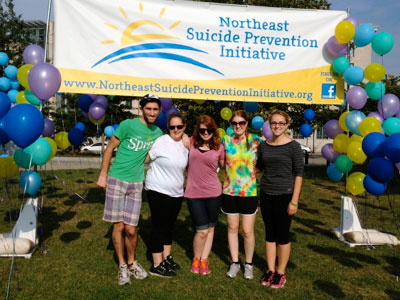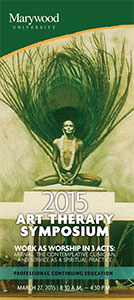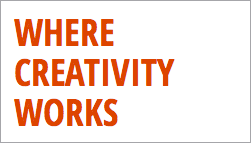Art Department: Art Therapy
- Undergraduate Programs
- Graduate Programs
- Facilities
- Faculty & Staff
- Student Work
- Weekend Art Workshops
- Bayleaf Open
- Student Clubs & Organizations
- Student Resources
- Portfolio Guidelines
- Foundation Year
- Study Abroad
- Alumni Success Stories
- Medals for Art Excellence
- Accreditation
- Galleries
- News & Events
- Contact Us
Read Our Blog:

Jeremy Cantor
BFA Illustration, Marywood University 1987Full-time computer animation & story instructor at Ringling College of Art & Design
"After graduating with a degree in illustration, I worked as a tee-shirt artist, a graphic designer for a sign company, a freelance illustrator, a storyboarder, and a video game artist/generalist, before ultimately “settling” into the role of computer animator (and “rigger”) in the film industry."
More testimonials »Art Therapy
Marywood's art therapy program is designed to meet the needs of those interested in a career that includes both a commitment to art-making and a commitment to serving others. It will introduce you to the human service profession of art therapy at a pre-professional level.
A combination of studio art courses and behavioral and social science courses will fully prepare you for graduate study in art therapy. Master's level art therapy training then focuses on preparing students for professional practice.
Our program emphasizes the healing and therapeutic qualities of art, for ourselves as artists and for the clients we serve. You'll be taught and guided by registered and board-certified art therapists who are active clinicians and artists. Coursework emphasizes hands-on experience.
Download the course sequence sheet for a breakdown of classes each semester.
At Marywood, you'll have the opportunity to complete an art therapy internship in a mental health, medical, educational, or studio setting. This is essential training if you're considering future education and a career as an art therapist.
Above all, the making of art is central to the spirit of our art therapy program. You will leave Marywood as a capable artist and advocate of humanistic engagement with others through the artistic process. For more information on our art therapy program, contact Professor Stephanie Wise at [email protected].
The Art Therapy Program is pleased to announce the introduction of a new BA2MA 5Year Accelerated Program Track. This program seamlessly combines the current Pre-Professional Undergraduate and Professional Graduate Art Therapy Programs into a 5 year accelerated structure. At the 90 credit point, undergraduate students who carry a 3.0 or greater GPA may apply to be admitted to the 5 Year plan resulting in a savings of both time and money. For more details, please contact Art Therapy Program Director Stephanie Wise at [email protected].
Student Organizations
MUSATA (Marywood University Art Therapy Association)
MUSATA is composed of graduate and undergraduate art therapy students with the support of the Marywood art therapy faculty. The main purpose of this group is to network, share personal, artistic, educational, and overall professional growth opportunities. This group strives to promote art therapy as a means of life improvement. MUSATA seeks out volunteer opportunities so that its members can gain experience with a variety of populations while lending a helping hand in accordance with Marywood's curricular goal of service learning. For more information, contact [email protected].

Past Volunteer Events
MUSATA (Marywood University Student Art Therapy Association) attended the Northeast Suicide Prevention event that occurred on September 6th, 2014 at Linden Street located downtown Scranton, PA. MUSATA members volunteered to assist with decorating the vine archway leading into the event. Ribbons, quotes, and pictures were hung throughout the vine archway to advocate for suicide prevention, along with a memoriam wall of victims who had committed suicide. MUSATA Members also participated in the mile “Share the Journey” walk.



Events:
 SAVE THE DATE for the 2016 Marywood Art Therapy Symposium
SAVE THE DATE for the 2016 Marywood Art Therapy Symposium
Art Therapy in End-of-Life Care:
The Power of Creativity in Exploring Life, Loss, and Grief
featuring Mary B. Safrai, ATR-BC, LCAT, Reiki MasterOver the course of the Symposium, participants will learn about the growing acceptance of hospice and palliative care in our communities and will discover the power of creative arts for patients and caregivers. Additionally, participants will learn about the variety of ways that grief manifests and will explore how engagement with loss and grief can be empowering in one’s own life.
For more information, contact Dr. Barbara Parker- Bell
 2015 Art Therapy Symposium
2015 Art Therapy Symposium
Work as Worship in 3 Acts: Arrival, The Contemplative Clinician, and Service as a Spiritual Practice
Friday, March 27, 2015
8:30 a.m.- 4:30 p.m.
Presenter: Dr. Michael Franklin
PROGRAM DESCRIPTION:
This symposium will focus on approaching Art therapy as an opportunity to surface, blend, and integrate multiple professional identities. Included in the artist-therapist self-structure are other traits including the contemplative, transpersonal, and socially engaged self. Later in the day there will be an afternoon workshop that explores these themes by materializing through clay, the I/Thou relational textures of the empathic imagination.
For more information, contact Dr. Barbara Parker- Bell
Download the brochure for more information

2014 Art Therapy Symposium
Art Therapy with Students at Risk: Fostering Resilience and Growth Through Creative Self-Expression
Friday, April 11, 2014
8:30 a.m.- 4:30 p.m.
Presenter: Stella A. Stepney, M.S., ATR-BC, LCAT
PROGRAM DESCRIPTION:
This symposium will focus on fostering resilience and growth through self-expression with diverse at-risk student populations. Through a combination of lecture, art making, and discussion, participants will gain an understanding of the “four worlds of childhood,” associated risk/protective factors, and the rationale for using art expression to foster resilience in this population.
For more information, contact Dr. Barbara Parker- Bell
Download the brochure for more information

2013 Art Therapy Symposium
A Social Justice Approach to Art Therapy: Global to Local Perspectives
February 14th, 2013
8:45 a.m.- 5 p.m.
Presenter: Catherine Moon, MA, ATR-BC
PROGRAM DESCRIPTION:
This symposium is focused on a social justice approach to art therapy that emphasizes reflexivity, power sharing, and cultural relevance. An ongoing project to develop therapeutic arts programs in Kenya and Tanzania provides an example of the challenges and practical application of this model in an international context, while a community-based studio project in Chicago provides a model for how a social justice approach can be applied at the local level.
For more information, contact Dr. Barbara Parker- Bell
Download the brochure for more information
Global Perspectives in Creativity, Art Therapy, Counseling and Psychology
The Global Perspectives in Creativity, Art Therapy, Counseling and Psychology project is a result of collaboration between Marywood University and Tomsk State University, Tomsk, Siberia, Russian Federation. The aim of the project is to provide scholars, students, and the general public an opportunity to see differences and similarities in thinking and practice of psychologically oriented and creative professions in Russia and the USA. Professors from Marywood and Tomsk State University describe and discuss related research in events that will took place live with participation from audiences in Tomsk and Scranton simultaneously.
To learn more, visit:
marywoodandtomsk.wordpress.com
The Sandtray Room
Check out Marywood University's New Sandtray Room!
Sandtray is a form of therapy that allows clients to create their own representations of their world and experiences using miniature figures and sand. These creations are metaphors of the client’s life and serve as a means for the client to reflect on conflicts, obstacles, and self-acceptance. Sandtray therapy is beneficial for a range of ages and populations. As in art therapy, sandtray therapy can be carried out non-verbally and contains symbolism of the client’s inner world (Zhou, 2009). The sandtray room at Marywood University enables students to directly experience and learn about the processes of sandtray therapy.
To learn more visit:
http://marywoodsandtray.wordpress.com/







